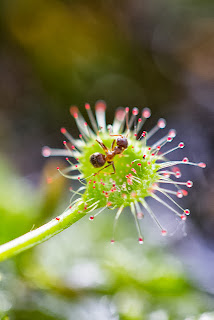When visiting Camosun Bog you might hear or catch a glimpse of a few cagey carnivores that love to eat insects, such as the Pacific tree frog (Pseudacris regilla), Northwestern salamander (Ambystoma gracile) or a variety of bird species that inhabit the Bog. However, there is one living organism, that, even though it grows in plain sight, you might never guess, it also ensnares and digests insects as prey. This inconspicuous carnivore is a flowering plant, or angiosperm, called the Round-leaved sundew (Drosera rotundifolia). The Round-leaved sundew is a common sundew species found across British Columbia in bogs, marshes, fens and other wet habitats where the soil is poor in nutrients, especially nitrogen. The sundew has adapted to these habitats by finding needed nutrients elsewhere, in particular from the strange yet fascinating and important world of insects. The Round-leaved sundew mainly feasts on midges, gnats and mosquitoes; however, it has the ability to digest insects the size of small flies and ants. The small and rounded leaves of the Rounded-leaved sundew grow in a basal rosette formation. These leaves are equipped with hairy tentacles called laminae. The laminae are stalked with sweet, sticky mucilage that appears like morning dew and attracts tasty insects. Once the insect is trapped, the sundew secretes various enzymes that digest and extract a form of nitrogen and other nutrients from the soft parts of the insect’s body. Many people are aware of other carnivorous plants, such as the Venus flytrap (Dionaea muscipula) or Pitcher plant (Nepenthes spp.); however, these plants are not native to the Lower Mainland, British Columbia. The Round-leaved sundew is local, found right here in UBC’s own backyard in Camosun Bog. Camosun Bog is an unfamiliar and open ecosystem that dates back to 2,000 years ago. Its characteristics components consist of sunlight, nutrient-poor soil and sphagnum moss. Now is an excellent time to view the Rounded-leaved sundew in Camosun Bog as its dew-like mucilage shimmers in the summer sun and its white, five-petalled flowers are blooming. Camosun Bog is located in Pacific Spirit Regional Park at the corner of W 16th and Camosun Streets. When you visit the Bog, make sure to explore the other weird and wonderful plant species of this ecosystem as well as the sundew, including the 13 different species of Spagnum mosses (Sphagnum spp.), Labrador Tea (Ledum groenlandicum), and the Arctic starflower (Trientalis europaea), to name just a few. These species are largely accessible to visitors because of a group of highly-dedicated volunteer nature-lovers, the Camosun Bog Restoration Group (also known as the Crazy Boggers). Since the early 1990s, the Camosun Bog Restoration Group has worked with Metro Vancouver park management and the Pacific Spirit Park Society to restore the Bog. You can also experience a piece of Camosun Bog at the Beaty Biodiversity Museum on campus at 2212 Main Mall. Susan Chung of the Camosun Bog Restoration Group generously loaned the Museum a mini piece of the bog for public access and education. This mini bog displays some of Camosun Bog’s amazing plant species, including the Round-leaved sundew, Labrador tea, Bog laurel (Kalmia microphylla ssp. occidentalis), Bog cranberry (Oxycoccus palustris), Oval-leaved blueberry (Vaccinium ovalifolium) and the Arctic starflower. --This article was first published in The Campus Resident Magazine Volume 4 Issue 8, August 19, 2013 |
skip to main |
skip to sidebar
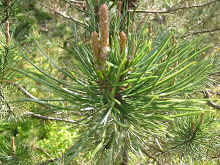
coniferous tree, dh
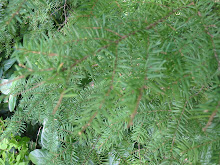
a tall coniferous tree, its needles can be made into a lemony tea
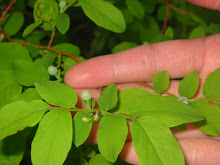

sk
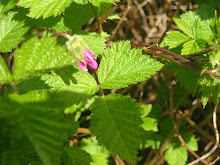
dh

sk
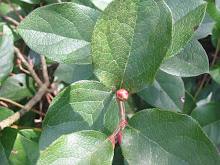
dh
nature notes on an urban bog
Donate to Camosun Bog Restoration Group
Support our work by donating to Pacific Spirit Park Society and writing Camosun Bog Restoration in the memo
Camosun Bog Restoration Group Website
native: sundew, carnivorous bog plant
Place-based education
research
native: Bog Laurel or Kalmia
native: lodgepole pine

coniferous tree, dh
Invasive: Western Hemlock tree

a tall coniferous tree, its needles can be made into a lemony tea
Blueberry, some varieties native, others invasive

invasive: skunk cabbage

sk
invasive: salmonberry

dh
invasive: brackenfern with some salal in the background

sk
invasive: salal

dh
camosun bloggers
Labels
animal remains
(3)
animals in the bog
(3)
baby sundew
(1)
Beaty museum
(1)
Bin Day
(1)
birding
(1)
birth of a sundew
(1)
blue whale
(1)
blueberry or huckleberry
(3)
bog artifacts
(4)
bog buddy program
(3)
bog cranberry
(1)
bog depth
(1)
bog therapy
(3)
bogs in shakespeare
(2)
bryophyte
(2)
bullfrog
(2)
bunchberry
(1)
bunchberry mutation
(1)
camosun bog restoration group
(9)
CBRG
(1)
coins
(1)
coyote
(2)
dog fence
(2)
dormant sphagnum
(1)
evolution
(1)
frog
(5)
fungi
(1)
healing bog
(1)
helicopter view
(1)
herbal medicine
(1)
history of Vancouver
(1)
hockey in camosun bog
(2)
hummingbird
(1)
invasive species
(4)
jughead hat
(1)
kalmia
(1)
killarney bog
(1)
labrador tea
(2)
labrador tea recipe
(1)
lichen
(2)
life cycle
(1)
little boggers
(3)
love
(1)
marbles
(1)
minibog
(1)
moss reproduction
(2)
mummy
(2)
mushroom
(1)
native species
(1)
new signs
(1)
night quest
(1)
our sustainable region
(1)
peat layers
(3)
photos
(1)
place based education
(4)
place based education camosun bog restoration biology
(4)
poem
(1)
poison
(1)
Pro-D
(1)
rain
(1)
rodent
(2)
salal
(1)
scat
(1)
skull
(1)
sphagnum
(9)
sphagnum moss
(4)
stanley park bog
(1)
stories
(4)
storm
(1)
stump removal
(1)
sundew
(4)
sundew germination
(1)
sundew seeds
(1)
symbiotic
(2)
tiny sundew
(1)
tree
(1)
tree frog
(4)
vaccinium ulginosum
(1)
vacciniums
(2)
young crazy bogger
(2)

